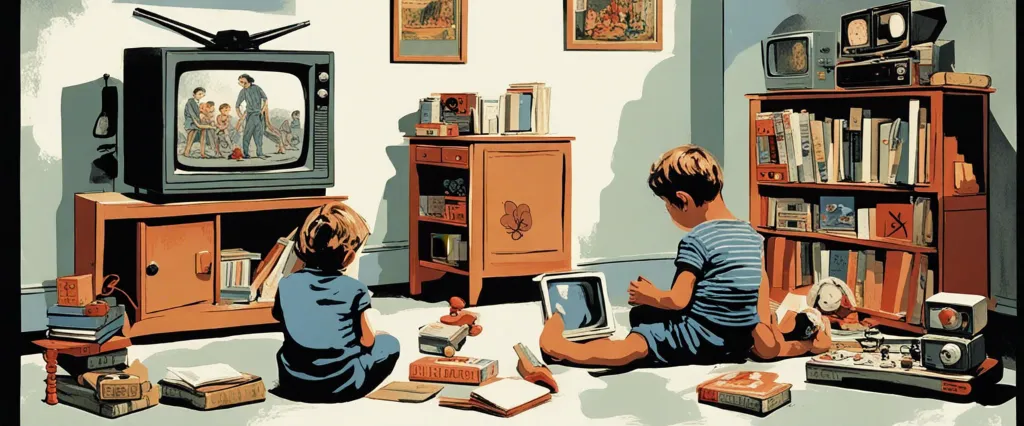In his thought-provoking book, “The Disappearance of Childhood,” Neil Postman explores the remarkable transformation of childhood in modern society. Postman, a renowned media theorist and cultural critic, draws upon his extensive knowledge to examine how the advent and proliferation of technology, namely television, has dramatically altered the concept of childhood. Through an astute analysis of historical, sociological, and psychological perspectives, Postman seeks to understand the erosion of childhood innocence and its consequences in an increasingly technologically driven world. This summary delves into the primary themes and arguments put forth by Postman in his influential work.
Chapter 1: Introduction to Childhood
Chapter 1 of The disappearance of childhood by Neil Postman provides an introductory overview of the concept of childhood and its historical transformation. Postman argues that childhood, as we understand it today, is a relatively recent social invention. He explores the distinctions between children and adults throughout different time periods and societies to illustrate how childhood has evolved.
Postman starts by discussing the ancient Greeks and Romans, where children were seen as miniature adults and were not afforded any special privileges or protections. He then looks at the Middle Ages, highlighting the emergence of a distinct concept of childhood. In this period, children were considered inherently sinful and corrupt, and their innocence had to be preserved through strict control and discipline.
Moving forward, Postman discusses the role of literacy and the print revolution, which had a profound impact on the development of childhood. As books became more accessible, they created a separation between the adult world of knowledge and the child’s world of innocence and ignorance. This led to the emergence of children’s literature and the idea of educational toys and games, which reinforced the idea of a distinct childhood.
Postman also examines the impact of technological advancements, such as television, on the disappearance of childhood. He argues that mass media has eliminated the gap between the adult and child worlds, as children are now exposed to adult themes and entertainment from an early age. This blurring of boundaries results in an accelerated loss of childhood innocence and a premature transition into adulthood.
In conclusion, Postman sets the stage for his exploration of the disappearance of childhood in the modern world, emphasizing the historical and societal factors that have shaped our understanding of childhood. He highlights how changes in literacy, the print revolution, and media technology have contributed to the erosion of the traditional distinctions between children and adults.
Chapter 2: The Influence of Media
In Chapter 2 of “The Disappearance of Childhood” by Neil Postman, titled “The Influence of Media,” the author explores how modern forms of media have transformed the way society perceives childhood and the development of children. Postman argues that the introduction of various media, such as television, has eroded the boundaries between childhood and adulthood, blurring the distinction between the two stages of life.
Postman begins by discussing the historical belief in the separation of adults and children, highlighting that childhood was considered a distinct stage in which children were protected from the adult world. However, he argues that with the rise of television and other mass media, children have been exposed to adult content at an earlier age. The acceleration of technology has compressed the time taken for children to acquire adult knowledge and behaviors, resulting in the disappearance of a prolonged period of innocence.
Postman further observes that this media saturation has eliminated many traditional methods of child-rearing and education. Instead of being taught by parents or learning in formal educational settings, children are now primarily educated by media, which presents both factual information and values. He suggests that the influence of media on children’s development and understanding of the world is often overlooked and underestimated.
The author also argues that media functions as an agent of socialization, shaping children’s beliefs, behaviors, and values to match the dominant societal norms. Postman points out that media content designed for children often lacks depth and encourages passive consumption, resulting in a decline in critical thinking skills. He argues that the media’s influence has diminished the necessity for children to exercise their imagination and creativity, as they are constantly provided with pre-determined and ready-made entertainment.
In conclusion, Chapter 2 of “The Disappearance of Childhood” examines how the advent of various media forms has eroded the boundaries between childhood and adulthood. Postman argues that this exposure to adult content at an early age, coupled with the educational influence of media, has had a significant impact on children’s development, blurring the lines of innocence and hastening the transition into adulthood.
Chapter 3: The Commodification of Childhood
Chapter 3 of “The Disappearance of Childhood” by Neil Postman is titled “The Commodification of Childhood.” In this chapter, Postman explores how childhood has been transformed into a marketable commodity in contemporary society.
Postman begins by explaining that the concept of childhood as a distinct stage of life is relatively recent, emerging in the 18th and 19th centuries. However, he argues that today, childhood has become commercialized and commodified to an unprecedented extent. He discusses how advertisers and marketers target children as an influential consumer group, exploiting their vulnerability and susceptibility to persuasion.
Postman contends that toys and media play a significant role in this commodification process. Companies manufacture and market a range of products specifically designed to appeal to children, perpetuating the idea that happiness and satisfaction can be found through the consumption of material goods. Furthermore, he suggests that the media plays a crucial role in shaping children’s desires and expectations, as they are bombarded with advertisements and entertainment that promote materialism and instant gratification.
Postman highlights the negative consequences of the commodification of childhood. He argues that, as a result, children are denied the opportunity to develop critical thinking skills and are instead encouraged to passively consume. Additionally, he argues that this process erodes the boundaries between childhood and adulthood, leading to the disappearance of traditional markers that once defined childhood as a separate and protected space.
In conclusion, Chapter 3 of “The Disappearance of Childhood” explores how childhood has become a commercialized commodity, with children being targeted as consumers from an early age. Postman emphasizes the detrimental effects this has on children’s development and the blurring of boundaries between childhood and adulthood.
Chapter 4: The Erosion of Innocence

Chapter 4: The Erosion of Innocence of Neil Postman’s book The Disappearance of Childhood explores the impact of media on children and the erosion of their innocence. Postman argues that childhood has been significantly affected by the rise of mass media and the decline of print culture.
Postman begins by discussing the historical concept of childhood, which emerged in the seventeenth century as a distinct phase in life. He argues that the key characteristic of childhood was the separation between the adult world and the world of children, with adults being responsible for raising and protecting children from adult experiences. However, this separation has been weakened by the influence of media, particularly television.
Postman suggests that television has eroded the boundary between childhood and adulthood by exposing children to the same content as adults. He points out that television blurs the lines between reality and fiction, reducing the importance of imagination and fantasy play in children’s lives. Moreover, he criticizes the trend of programming that caters directly to children, suggesting that it reinforces the idea that children have little capacity for critical thinking and independent judgment.
Postman also highlights the impact of advertising on children, arguing that it targets their innocence and vulnerability. He contends that advertising shapes children’s values and desires, emphasizing materialism and instant gratification, and encourages them to become consumers from an early age. This, in turn, contributes to the erosion of their innocence as it exposes them to the adult world of commerce and materialism.
In conclusion, Chapter 4 examines how the rise of mass media, particularly television, has eroded the innocence of childhood. Postman suggests that the blurring of boundaries between adulthood and childhood, as well as the influence of advertising, has greatly impacted children’s experiences and development.
Chapter 5: Education and the End of Childhood
Chapter 5 of “The Disappearance of Childhood” by Neil Postman is titled “Education and the End of Childhood”. In this chapter, Postman explores the relationship between education and the changing concept of childhood.
Postman begins by examining the historical development of education, highlighting the shift from one-room schoolhouses to mass education systems. He argues that education has played a crucial role in shaping the idea of childhood and preparing children for adult responsibilities. However, he asserts that the traditional purpose of education, which was to transmit cultural knowledge and values, has been disrupted with the advent of modern technology and media.
Postman then delves into how today’s education system, influenced by the rise of television and the internet, undermines the distinctiveness of childhood. He suggests that in the past, education provided a protected space for children to learn and grow without being prematurely exposed to adult ideas and concerns. However, with the erosion of boundaries between childhood and adulthood, children are now exposed to adult content, language, and behaviors at an earlier age.
Furthermore, Postman discusses the impact of technology on education, highlighting the emphasis on efficiency and instrumental learning rather than fostering critical thinking and creativity. He argues that this narrow focus on utility diminishes the value of education as a means of intellectual and moral development, further eroding childhood.
In conclusion, Postman posits that education today fails to preserve and nurture childhood due to the encroachment of technology and the blurring of boundaries between childhood and adulthood. He implores educators and parents to recognize the importance of preserving childhood as a distinct and valuable stage of life, emphasizing the need for a more holistic and humanistic approach to education.
Chapter 6: The Role of Technology
In Chapter 6 of “The Disappearance of Childhood” by Neil Postman, titled “The Role of Technology,” the author explores the effects of technology on the concept of childhood and its disappearance. Postman argues that the inherent characteristics of technology, specifically television, are eroding the boundaries that once separated childhood and adulthood.
Postman begins by discussing how technology removes the distinctions between the experiences of children and adults. He asserts that television, as a medium, reduces complex ideas into easily digestible fragments, diminishing the need for cognitive development in children. By presenting knowledge and entertainment in an entertaining and simplified format, television leaves no room for the slow and often difficult process of acquiring knowledge through traditional means.
Furthermore, Postman argues that technology has undermined the authority of parents and traditional educational institutions. With the proliferation of information available online, children no longer solely rely on parental guidance or classroom education. Instead, they can access a vast amount of information from various sources, often undermining the dominance of adults as the sole provider of knowledge.
Postman also explores how technology has blurred the distinction between fantasy and reality, noting that television presents a constant stream of images that make it difficult for children to distinguish between the two. This blurring of reality hinders children’s cognitive development, as they struggle to understand the difference between what is portrayed on screen and what exists in the real world.
The author concludes the chapter by emphasizing that technology, particularly television, has played a significant role in the disappearance of childhood. By eroding the boundaries between children and adults, diminishing the role of parents and traditional educational institutions, and blurring the line between fantasy and reality, technology has fundamentally altered the way children experience the world.
Chapter 7: Parenting in the Modern Age
Chapter 7 of “The Disappearance of Childhood” by Neil Postman discusses parenting in the modern age, focusing on the impact of television and other media on the relationship between parents and children. Postman argues that childhood is becoming diluted and erased due to the encroachment of adult values, and this is largely facilitated by the pervasive presence of media in children’s lives.
Postman begins by dissecting the shift from the traditional concept of childhood, which was associated with innocence, playfulness, and a sense of separateness from the adult world. He suggests that technological advancements, particularly the invention of television, have blurred the line between childhood and adulthood. Television exposes children to adult themes and thoughts, eliminating the buffer that once sheltered them from the complexities and harsh realities of adult life.
The author contends that parents, disregarding the importance of childhood as a distinct phase, are engaging their children in adult conversations and treating them as peers. The availability of media, which provides children access to adult information and entertainment, has further eroded the notion of childhood. Parents’ desire to stay relevant and befriend their children has inadvertently led to an erosion of parental authority and created confusion about children’s role in society.
Postman suggests that society needs to recognize the value of childhood and the importance of protecting children from adult influences until they are developmentally ready. He implores parents to create boundaries around the media consumption of their children and be mindful of what is appropriate for their age group.
In conclusion, Chapter 7 of “The Disappearance of Childhood” highlights the detrimental consequences of media exposure on the concept of childhood and the parent-child relationship. Postman urges parents to reclaim and preserve the innocence and protective boundary that childhood should encompass in order to foster a healthy upbringing for future generations.

Chapter 8: Preserving Childhood
Chapter 8 of “The Disappearance of Childhood” by Neil Postman is titled “Preserving Childhood.” In this chapter, Postman discusses the impact of technology and media on the concept of childhood.
Postman begins by emphasizing that childhood is a social construct, shaped by culture and society. He argues that childhood is a relatively recent invention, emerging in the seventeenth century with the rise of printing, literacy, and the need for educational institutions. However, he notes that advances in technology, particularly television, are threatening the very essence of childhood.
Postman claims that television has blurred the line between childhood and adulthood. Historically, children were protected from the adult world, with their own separate realm. Yet, with television, children are exposed to the same content as adults, erasing the boundaries that once existed. This, according to Postman, leads to the erosion of innocence and the loss of a distinct stage of life.
Postman also argues that the rise of advertising further accelerates the disappearance of childhood. Advertisements target children, enticing them to become consumers, thereby treating them as miniature adults rather than allowing them to grow naturally. He contends that this consumer culture robs children of their imagination, creativity, and the ability to engage in play without the need for material possessions.
Lastly, Postman highlights the importance of preserving childhood as a necessary foundation for a healthy society. Childhood provides a unique space for children to develop their own values, beliefs, and social roles. Preserving childhood requires conscious efforts to control the influence of technology and media, promoting spaces for unstructured play and nurturing children’s innate curiosity and imagination.
In summary, Chapter 8 of “The Disappearance of Childhood” explores how advances in technology, especially television, and the rise of consumer culture are erasing the boundaries of childhood. Postman emphasizes the need to preserve childhood as a distinct and protected state in order to promote healthy development and safeguard children’s creativity and imagination.
After Reading
In conclusion, Neil Postman’s book “The Disappearance of Childhood” explores the decline of a distinct and protected stage of life known as childhood. Postman examines the historical and cultural factors that have contributed to this disappearance, including the rise of technology, the erosion of traditional educational systems, and the prevalence of mass media. He argues that the blurring of boundaries between childhood and adulthood has profound implications for society, as children are increasingly exposed to adult content and responsibilities at an early age. Postman’s thought-provoking analysis serves as a wake-up call, reminding readers of the importance of safeguarding and preserving the innocence and unique developmental needs of childhood in our rapidly changing world.
1. The Shallows: What the Internet Is Doing to Our Brains” by Nicholas Carr – This book explores the impact of technology, particularly the internet, on our cognitive abilities and how it has reshaped our thinking patterns and behaviors.
2. “The Dumbest Generation: How the Digital Age Stupefies Young Americans and Jeopardizes Our Future” by Mark Bauerlein – In a similar vein to Neil Postman’s work, this book examines how today’s digital age has led to a decline in the intellectual and cultural development of younger generations.
3. “Alone Together: Why We Expect More from Technology and Less from Each Other” by Sherry Turkle – Turkle delves into the consequences of our heavy reliance on digital technology, highlighting how it has affected our interpersonal relationships and sense of genuine connection with others.
4. “The Filter Bubble: How the New Personalized Web Is Changing What We Read and How We Think” by Eli Pariser – This book raises concerns about the personalization algorithms underlying major online platforms, arguing that they can inadvertently limit our exposure to diverse perspectives and shape our worldview.
5. Amusing Ourselves to Death: Public Discourse in the Age of Show Business” by Neil Postman – Another thought-provoking work by Neil Postman, this book discusses how the dominance of television and other forms of entertainment media have transformed public discourse and influenced our perception of reality.




